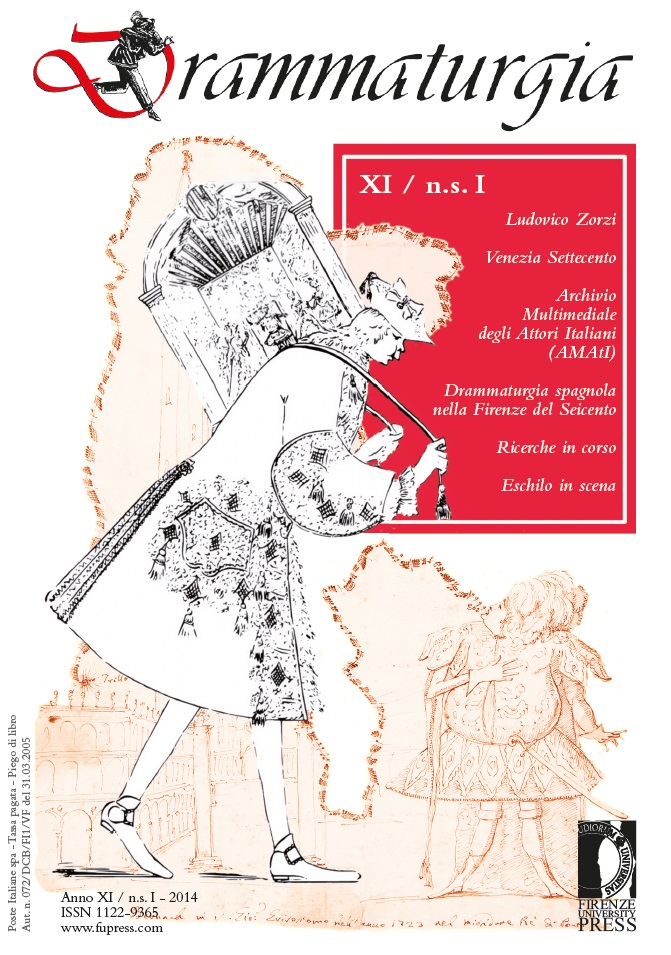«Caterina Bresciani, chi era costei?». Tragicommedia in tre atti con un prologo e un epilogo
Published 2014-12-18
Keywords
- Caterina Bresciani,
- dramaturgy,
- material history of performance,
- goldonian actors
How to Cite
Abstract
The paper presents the synthetic review of an investigation on the figure of the most important Goldonian actress; at the same time, it tries to outline a methodological and critical framework for any research involving comedians with whom the Goldonian dramaturgy related (as well as that of ‘rivals’ Chiari and Gozzi). In fact, this kind of investigation has to confront with a pronounced lack of primary sources and, conversely, with the exuberance of the testimonies the author left on ‘his’ actors. Testimonies that theatrical historiography mostly took without the necessary critical scrutiny, although the boundaries between ‘historical truth’, ‘invention’ and representative convention are, in these, often indecipherable. Caterina Bresciani is a sample paradigm of this impasse: despite her absolute centrality in the artistic universum of the playwright, a deep mystery continues to hover around her human and artistic personality, so obscured by the lack of certain documentaries as by the representative clichés with which Goldoni handed down her memory. For the first time, the traits that remained hidden behind the ‘Ircana’s mask’ are here revealed, by a process that verifies the master data of the Florentine actress, her social backgrounds, her professional profile on the acting debut on the Venetian ‘scene’, her physical and recitative characteristics, demonstrating the impact that the so-called material history of the show – in the matter of a certain interpretative individuality – played for the most decisive phase of the Goldonian dramaturgical evolution.
Il contributo presenta il ragguaglio sintetico di un’indagine sulla figura della più importante attrice goldoniana, e al tempo stesso cerca di delineare un quadro di riferimento metodologico e critico per ogni studio relativo ai comici con cui si confrontò la drammaturgia dell’autore (ma anche quella dei ‘rivali’ Chiari e Gozzi). Un’indagine di tale tipo deve infatti confrontarsi con una pronunciata ristrettezza di fonti primarie e, per converso, con l’esuberanza delle testimonianze lasciateci dall’autore sui ‘suoi’ attori, testimonianze per lo più assunte dalla storiografia teatrale senza il necessario vaglio critico, pur essendo in esse spesso indecifrabili i confini tra ‘vero storico’, ‘invenzione’ e convenzione rappresentativa. Di questa impasse Caterina Bresciani rappresenta un campione paradigmatico: nonostante la sua assoluta centralità nell’universum artistico del commediografo, un fitto mistero continua ad aleggiare attorno alla sua personalità umana e artistica, oscurata tanto dall’assenza di dati documentari certi, quanto dai clichés rappresentativi con cui Goldoni ce ne ha tramandato memoria. Per la prima volta vengono qui rivelati i tratti nascosti dalla ‘maschera di Ircana’, in un percorso che dell’attrice fiorentina accerta l’identità anagrafica, l’origine sociale e il profilo professionale all’atto dell’ingresso sulla ‘scena’ veneziana, le caratteristiche fisiche e recitative, dimostrando l’incidenza che la cosiddetta storia materiale dello spettacolo – nell’incarnato vivo di una specifica individualità interpretativa – rivestì per la fase più decisiva dell’evoluzione drammaturgica goldoniana.


